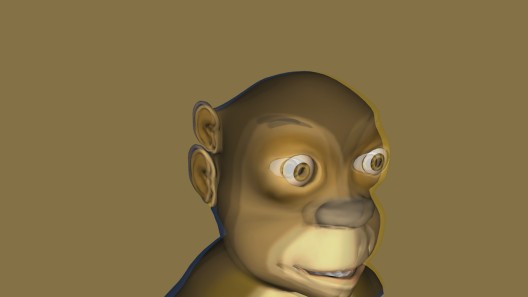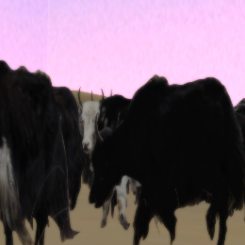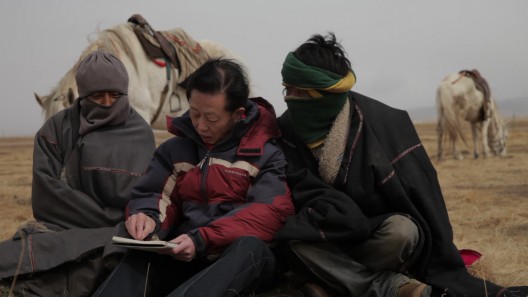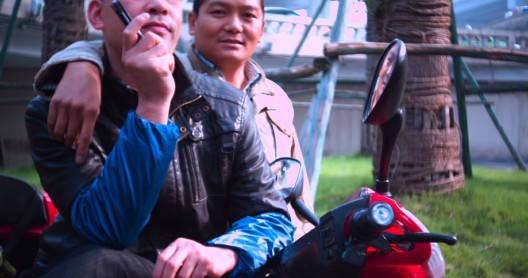This piece is included in Ran Dian’s print magazine, issue 3 (Spring 2016)
In July 2015, the London-based artist Shen Xin staged her project “Shoulders of Giants” as a symposium extended through animation, performance, and projection. During the event, when the Marxist theorist and researcher Esther Leslie described the historic avant-gardists’ impulse to liquidize themselves, the world, and the revolution, by “liquidization” she meant automatic writing as a technique that has transformed texts and images into an endless “enchanted, half-recognizable monster at the changing.” On the other side, speaking similarly through the role of a Chinese mythological creature, Goldsmiths college lecturer Mark Fisher fervently portrayed the way in which the global capitalist machine captures with precision human affect and labor. The discussion was at times heated, especially when Fisher sparred with the artist Hannah Black over whether or not a system that produces a sense of boredom has an entirely negative effect on creativity. But Shen Xin did not seem inclined to mediate the debate. Rather, she turned the lecture hall at the Senate House at the University of London into a space for a free melee of signs, where all four performers/speakers spoke, at the artist’s invitation, through their choice of avatar drawn from The Classic of Mountains and Rivers, a mythic geographical text dating back to the Han dynasty.

沈莘,《巨人的肩膀》,录像剧照(会议装置的实时动画),2015 / Shen Xin, “Shoulders of Giants”, video still (motion capture animation of symposium), 2015
For Shen Xin, whose practice includes filmmaking, performance, web-based works, and virtual reality, “Chinese-ness” implies a field of signifiers, the fluctuation of which is often disguised beneath seeming normativity as determined by Chinese societal formation. Upon examination, however, we find that her work frequently points outside this normativity and toward subjects from a variety of social groups. In this playground of gender and identity formation, Shen focuses on the ways in which the stakeholders of China-as-a-sign belong also to these “other” groups.
This artistic interest can be traced back to Shen’s student days, when her work enacted an aesthetic interrogation of her father, who specialized in naturalistic portraits of Tibetan minorities; she raised issues concerning visuality and power and the give-and-take between the producer and the subject of an image, as well as production and exploitation. For the documentary film Counting Blessings, made between 2012 and 2014, Shen took her camera and traveled into Tibetan areas with her father. While he staged photographs with local Tibetans, she sought out the gaps between his photo shoots, where traces of Han Chinese fantasies about Tibetans could be found. She covered her living expenses by making portraits of Tibetan people. For Shen, this process of image circulation and exploitation was her way of earning a living (occasionally she sold these pieces through her father’s ink painting networks).
Counting Blessings perhaps also touches on another issue worthy of discussion: China’s so-called “second-generation artists” (yi’erdai), born in artistic families into “privilege”—which can be considerable under the spoils of the official (socialist and strongly state-run) art system. Arguably, this three-word phrase also manifests underlying influence from the aforementioned normativity; it borrows from the bureaucratic mentality of cronyism, and conceals the fact that the producer of art is in the end an object produced by the overall system of image production and power. In this sense, could we not say that Shen’s Oedipal prologue is equally a prologue by and on the condition of a “second-generation artist?” The works made during Shen’s student years can be seen as a manifesto for her entry into the realm of image production. Particularly delightful is the nugget of revelation hidden within the works: Shen had long surfed the maelstrom of images that is contemporary visual culture—indeed, one might even say she was born into it.
In recent years and for certain reasons—perhaps as a repercussion of the Beijing Olympics—“Chinese-ness” has frequently been subjected to a subtle linkage with a neo-imperial imaginary of a (new) “Celestial Empire”1 (to the point where one Shanghai-born curator decided to move to Beijing, citing as the reason “shame” over Shanghai’s once-colonial past; or the number of art professionals in China who would consider dissenting views on China as “vilifying China,” regardless of whatever such words mean in their eyes). In Shen Xin’s work, however, “Chinese-ness” is manifested in other forms—not only in the description and statement of that “plateau rouge” on the cheeks of Tibetans, but also (in her 2014 work “Records of Rites”) in the 4.9 billion yuan (approximately $750 million U.S. dollars) Chinese corporate fund set to practically eclipse local London residents’ role in rebuilding the Crystal Palace, and again in the dissolute comradeship among young wastrels from Chengdu in “The Gay Critic” video project (2015). In these works, we find the mythological monsters in “Chinese-ness,” as well as a queer side of things. One might sometimes even sense that Shen likes to pair monstrosity with queerness. In “Records of Rites”, for instance, the artist overlays different layers—the reversal of roles between local Londoners and Chinese outsiders, news reports about Chinese capital, quotes from Confucius’s Analects, and visiting Chinese artists’ anecdotes about language problems abroad—to form a discussion, as if they were connected in essence.
That these seemingly conflicting ideas can attract and cue reactions in the viewer owes to the freestyle navigation of Shen’s film editing. In her film essays she assembles the visual materials that extend out from pools of images, each of which is ordered and selected according to a specific keyword, then shuffles and integrates the images into the sequential space of the moving image as if each keyword selected must compete for its own symbolic territory. In Esther Leslie’s formulation, these symbols are liquid, just as identity is. In such a post-national context, the right way to present the nation-state is perhaps as Shen Xin does, connecting symbols with their various physical manifestations à la automatic writing—as it happens, like the title of her upcoming work to be shown in London at Chisenhale Gallery—manifesting how “Forms Escape”.
Note
1. Tianchao (Celestial Empire) was originally an imperial, Sinocentric term to refer to China and its centrality in the world. In recent years, beyond its chauvinistic connotations, the term has taken on a satirical dimension when used to critique those in power and the ideology of political repression, economic liberalization, and the repudiation of the legacy of the Enlightenment.





